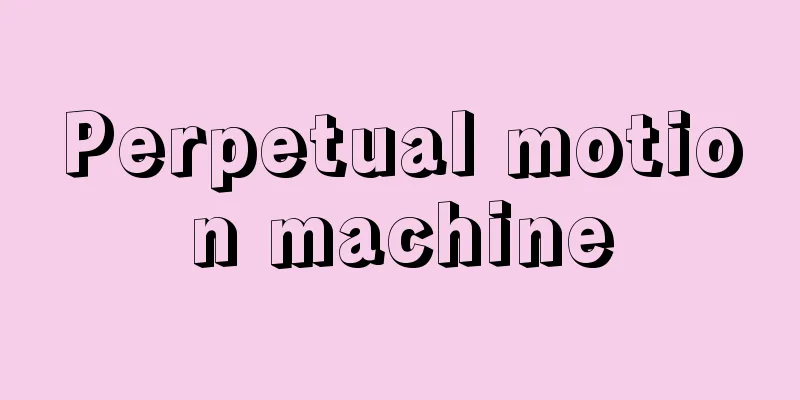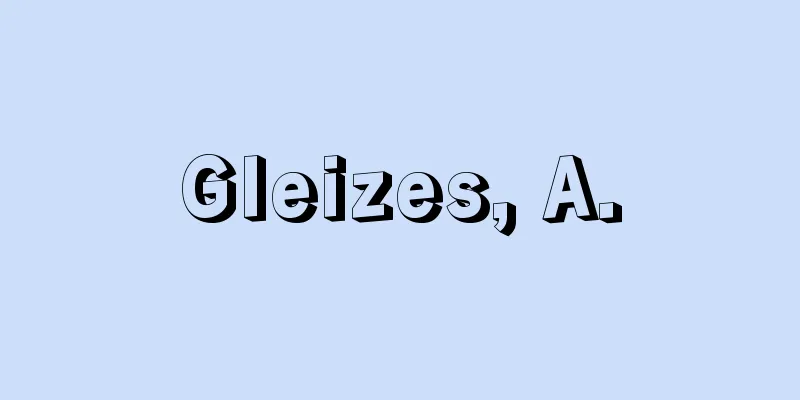Perpetual motion machine

|
A fictitious power engine that can continue to do work forever. A machine that can continue to do work without being supplied with energy is called a perpetual motion machine of the first kind, and a machine that absorbs heat (quantity) from a single heat source and continues to convert it directly into work for the outside world is called a perpetual motion machine of the second kind. These two are collectively called perpetual motion machines. Before thermodynamics was established, it was thought that such perpetual motion machines, especially the second kind, might be possible, and there were many discussions and experiments, but it became clear that they were impossible. However, what is important is that, just as the many attempts at alchemy paved the way for modern science, the accumulated efforts to create this perpetual motion machine led to the establishment of thermodynamics. [Shozo Sawada] First kind of perpetual motion machineThermodynamics first shows that heat is a form of energy, just like mechanical, electrical, magnetic, and chemical energy. If heat is energy, then the law of conservation of energy should hold true, including in the case of heat. This is called the first law of thermodynamics. Thermodynamics deals with the internal energy of a system of matter. The first law of thermodynamics shows that the internal energy of a system of matter increases by an amount equal to the amount of mechanical, electrical, magnetic, and chemical energy applied to the system from the outside, as well as heat applied from the outside. Therefore, if no energy is supplied from the outside, the internal energy does not increase, and no work can be done for the outside. Thus, the first law of thermodynamics proves that perpetual motion machines of the first kind are impossible. [Shozo Sawada] Perpetual motion machine of the second kindAs far as heat is concerned, not only does the law of nature satisfy the law of conservation of energy, but it also adds the stricter condition that thermal phenomena are generally irreversible. This is the second law of thermodynamics. For example, when ice and boiling water are mixed, the ice melts and the water as a whole settles at a certain temperature, but the water at this temperature does not separate into ice and boiling water by itself. The second law of thermodynamics was expressed by W. Thomson (Lord Kelvin), one of the founders of thermodynamics, in the following way: "When a substance goes through a thermodynamic cycle (Carnot cycle), there is no heat engine that can absorb heat from only one heat source and convert it into an equivalent amount of work." The German Clausius, who was a contemporary of his, expressed the same content as "Heat cannot be transferred from a low-temperature body to a high-temperature body without leaving some other change behind." Setting the second law in this way is, in other words, nothing other than a declaration of the impossibility of a perpetual motion machine of the second kind. A heat engine that we can actually create releases a portion of the absorbed heat and produces external work equivalent to the difference. It is relatively easy to understand that a first kind of perpetual motion machine is impossible because it violates the law of conservation of energy. However, a second kind of perpetual motion machine does not contradict the law of conservation of energy. Its impossibility can be explained by the fact that heat is the result of the movement of a very large number of molecules that make up a substance. The unique nature of thermal phenomena expressed in the second law of thermodynamics can be fully understood by taking a microscopic standpoint. [Shozo Sawada] [Reference] |[First kind of perpetual motion machine] It is impossible to make a first kind of perpetual motion machine that can continue to move without receiving an external energy supply. [Second kind of perpetual motion machine] It is also impossible to make a 100% efficient heat engine (second kind of perpetual motion machine) that converts all heat directly into work. [Realizable engine] The only heat engines that can actually be made are those that release a portion of the absorbed heat and produce work equivalent to the difference externally . The feasibility of perpetual motion machines [Onucourt's hammer wheel] When the wheel is moved slightly from its balanced position, the weighted stick (hammer) on top falls. The momentum causes it to rotate. Then the next hammer falls. In this way, the motion continues. [Devices that use water power] A device that uses the force of water falling from a high place to rotate a spiral, and this rotation pushes the water up again. © Hayao Nogami "> Examples of Perpetual Motion Machines Source: Shogakukan Encyclopedia Nipponica About Encyclopedia Nipponica Information | Legend |
|
永久に仕事をし続けることができるという、架空の動力機関。エネルギーの供給を受けないで仕事をし続ける機械を第1種(の)永久機関といい、ただ一つの熱源から熱(量)を吸収して、これをそのまま外部への仕事に変え続ける機械を第2種(の)永久機関という。この両者をまとめて永久機関という。 熱力学が確立される以前には、このような永久機関、とくに第2種永久機関は可能かもしれないと考えられ、いろいろ議論されたり、実験されたりしたが、それらは不可能であることが明らかとなった。しかし重要なことは、錬金術への幾多の試みが近代科学への道を切り開いたと同じく、この永久機関をつくろうとする努力の積み重ねによって熱力学が確立されていったことである。 [沢田正三] 第1種永久機関熱力学ではまず、熱の性質は、力学的、電気的、磁気的、化学的エネルギーと同じく、エネルギーの一つの形態であることが示される。熱がエネルギーであれば、熱の場合も含めてエネルギー保存則が成り立つはずである。これは熱力学第一法則とよばれる。熱力学で取り扱うエネルギーはまず、物体系のもつ内部エネルギーについてである。熱力学第一法則は、一つの物体系の内部エネルギーは、この物体系に外部から加えられた力学的、電気的、磁気的、化学的エネルギーおよび同じく外部から加えられた熱と同等量だけ増大することを示す。したがって、外部からエネルギーの供給を受けなければ、内部エネルギーも増大せず、外部への仕事をなすこともできない。こうして、第1種永久機関は不可能であることが熱力学第一法則から証明される。 [沢田正三] 第2種永久機関熱が関与する限り、自然界の法則はエネルギー保存則を満たす、というだけでなく、いっそう厳しく熱現象が一般には不可逆的であるという条件も付加される。これが熱力学第二法則である。たとえば、氷と沸騰している水を混ぜると、氷は溶けて、その水全体は、ある温度に落ち着くが、この逆に、この温度の水がひとりでに氷と沸騰している水に分かれることはない。熱力学第二法則を、熱力学の創始者の一人であるイギリスのW・トムソン(ケルビン卿(きょう))は次のように表現した。「ある物質が熱力学的なサイクル(カルノー・サイクル)をたどるとき、ただ一つの熱源から熱を吸収して、それを当量の仕事に変えるような熱機関はありえない」。同時代のドイツのクラウジウスは、同じ内容を「なんらかのほかの変化を残さずに、熱は低温物体から高温物体へ移ることはできない」と表現した。第二法則をそのように設定することは、とりもなおさず、第2種永久機関の不可能性を宣言したことにほかならない。われわれが実際につくりうる熱機関は、吸収した熱の一部分を放出し、その差の当量の仕事を外部にするのである。第1種永久機関はエネルギー保存則に反するために不可能であることは比較的理解しやすい。しかし第2種永久機関はエネルギー保存則には矛盾しない。それが不可能なことは、熱が物質を構成するきわめて多数の分子の運動の結果であることから説明される。熱力学第二法則に表された熱現象の特異な性質は、微視的立場にたつことによって十分に理解される。 [沢田正三] [参照項目] |〔第1種永久機関〕 外部エネルギーの供給を受けないで運動をし続ける第1種永久機関は不可能である。〔第2種永久機関〕 熱をそのまま全部仕事に変える、効率100%の熱機関(第2種永久機関)も不可能である。〔実現しうる機関〕 実際につくりうる熱機関は、吸収した熱の一部分を放出し、その差の当量の仕事を外部にするタイプのものである©Shogakukan"> 永久機関の実現性 【オヌクールの金槌車】 つり合った位置から車がすこし動かされると、頂上のおもりのついた棒(金槌)が倒れる。その勢いで回転する。そして今度は次の金槌が倒れる。こうして運動が持続されていくという。【水力を利用したもの】 高所へ上った水が落ちる力を利用して螺旋を回し、その回転がまた水を押し上げるという装置©野上隼夫"> 永久機関の例 出典 小学館 日本大百科全書(ニッポニカ)日本大百科全書(ニッポニカ)について 情報 | 凡例 |
<<: Perpetual bonds - Eikyukousai
>>: Permanent Revolution (Russia)
Recommend
Diprion nipponica (English notation) Diprionnipponica
...One generation per year. The black pine sawfly...
Ghost Story of Moonlit Forest - Ghost Story of Moonlit Forest
...At the age of 20, she married the Kurachi fami...
Basement plate
…It is a plate-like structure that lines the unde...
comte
…Although it varies by country and era, the commo...
Otsuka Tomb - Otsuka Kofun
There are ancient tombs called Otsuka or Otsukayam...
Family name - surname
〘Name〙 Family name and clan name . Myoji. Family n...
Cost of sales - Uriagegenka (English spelling) cost of sales
One of the expenses necessary for a company's ...
Nangu Shrine - Nangu Shrine
Located in Tarui-cho, Gifu Prefecture. Formerly a ...
Mycobacterium tuberculosis
…When a person with tuberculosis, especially one ...
lesser panda
...A general term for the two species of mammals ...
Pig iron - Sen-tetsu (English spelling)
High-carbon iron made in a blast furnace. The pro...
"The Swordsman's Manual by Master Ittosai"
…The theorization of swordsmanship, influenced by...
dhātu (English spelling) dhatu
...Originally a Buddhist term, it means the space...
Poole, WF
…For example, the Encyclopedia, Buffon's Natu...
Aerosol
Also called an aerosol or aerosol. A type of disp...









